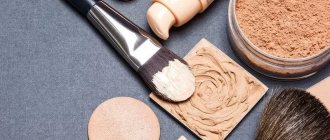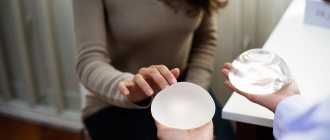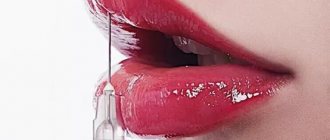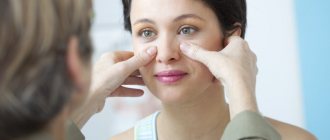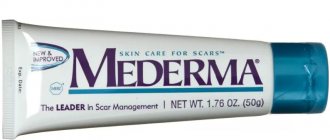How to recognize
The severity of the damage depends on several factors. For example, it depends on how strong the blow to the nose was, how strong the strength of the nasal septum is, and also on age.
You can understand that your nose is bruised by a number of signs characteristic of this injury. It is important to know them in order to take appropriate measures in time.
The symptoms of a common bruise are very similar to those of a broken nose. And yet it is necessary to learn to distinguish between them. Remember: the more severe the damage to cartilage, bone and soft tissue, the more pronounced the signs of injury.
In particular, a bruised nose manifests itself:
- Sharp pain of high intensity (it becomes much stronger if you even just touch the injured area). Note that the pain syndrome with a bruise is sometimes much more pronounced than with a fracture.
- Swelling (a lump appears). It appears almost instantly and gradually increases.
- Difficulty breathing through the nose - due to swelling and blockage of the nasal passages with blood clots.
- Bruises that inevitably appear under the eyes and in the nose area. This is the result of subcutaneous hemorrhage resulting from the blow.
- Tearing (this is an involuntary phenomenon, not crying).
- Bleeding from the nasal passages of varying degrees of intensity. Not a required sign. If the impact force was insignificant, and the vessels turned out to be strong enough, everything can be done without blood.
The highest severity of symptoms is observed for 2-3 days after the injury. Then they gradually disappear, giving way to the rehabilitation process.
If the nose is broken, its deformation will be obvious. In addition, a fracture is often accompanied by a painful shock, and in some cases, a short-term loss of consciousness. However, when there is a bruise, the nose swells so much that sometimes it is not clear whether it is an ordinary bump or the same deformity. The doctor will be able to make an accurate diagnosis only after 3-4 days, when the lump has decreased slightly. At the same time, modern technology today allows you not to waste time waiting, but to immediately find out whether your nose is bruised or broken. To do this, you will need to undergo an x-ray procedure, and in some cases, computed tomography, which is more informative.
A bruised nose poses a health hazard if it causes fainting, dizziness, and severe bleeding that cannot be stopped for an hour.
Sudden bruises under the eyes that look like dark glasses should also alert you. Typically, they indicate the presence of a more serious injury or a concussion. Doctors classify such a bruised nose as a traumatic brain injury. To find out how severe the injury was and whether anything else was damaged, you should definitely consult a doctor. And the sooner you do this, the better.
Rhinoplasty in Israel: correction of the wings of the nose
This type of surgery is performed to change the width, thickness and symmetry in the presence of pronounced aesthetic defects and deformities. Various techniques are used depending on the violations. For restoration, the tissue surrounding the defect is mobilized or a cartilage or skin graft is moved.
Correction of the wings of the nose can be an independent operation or the final stage of rhinoplasty in Israel.
Defects of the wings of the nose are acquired and congenital in nature, and can be complete or partial. The reasons are the consequences of nose correction or removal of tumors, trauma, burns and diseases.
Most operations to correct the wings of the nose are performed using local infiltration anesthesia. If extensive defects occur, intravenous anesthesia is used.
Sometimes tip plastic surgery is used to correct the wings of the nose. In this case, this operation will end rhinoplasty. If aesthetic defects are pronounced, correction is carried out during the main phase of the operation.
When it is necessary to reduce the distance between the wings of the nose, incisions are made at the base of the wings from the vestibule and along the contour. The skin and mucocutaneous segments are excised, hemostasis is performed, and sutures are applied. The scars are placed in the folds of the wings of the nose and natural nasolabial folds, making them virtually invisible.
If it is necessary to restore the support of the wings of the nose (in case of retraction or injury), sections of adjacent tissues are moved, a skin flap or one’s own cartilage from the auricle or nasal septum, specially modeled, is transplanted.
The rehabilitation period can last five days, in the case of reconstruction of the cartilage department - seven or more.
If a child bruises his nose
Under no circumstances should such trauma in a child be ignored. After all, if left unattended, it can lead to adverse consequences. If the baby hits his nose, in most cases there is swelling of the soft tissues of the injured area (a hematoma may also occur under the eyes after the blow) and minor bleeding. If the bruise is severe, a concussion and other unpleasant complications are possible.
Parents should know what to do when their child hits their nose hard. First of all, you should visit a doctor with your baby as soon as possible. The fact is that damaged soft tissues and swollen mucous membranes can significantly complicate nasal breathing.
If after a bruise a child begins to breathe heavily, most likely he has a hematoma on his nasal septum. In other words, detachment of the mucous membrane occurred with the penetration of blood into the resulting cavity. Due to the hematoma, the lumen of the nasal passages narrows, making it more difficult to breathe. In addition, it provides an excellent breeding ground for harmful microorganisms. And this already threatens with suppuration and abscess of the nasal septum.
Only the attending physician can recommend medications and methods for treating a bruised nose in a child, after having previously examined the child. Self-medication is strictly prohibited.
Rhinoplasty in Israel: support of the tip of the nose
The tip of the nose is supported by a stable, strong and correct arrangement of cartilage. Normally, they are located slightly above or below the line that is drawn along the back of the nose.
Insufficient support is caused by undesirable consequences of rhinoplasty (when adequate support is not provided) or age-related processes of tissue ptosis (ligaments that support cartilage weaken).
In order to create support, the entire outer nose is proportionally and correctly shaped. The nasolabial angle (formed by the upper lip and columella) is considered normal - 90-120°.
During the process of rhinoplasty in Israel, the tip of the nose can be raised seven to eight millimeters above the profile line of the back. The skin of the tip has difficulty adapting to changes because it is less elastic and thicker.
In order to restore support, transplanted cartilage grafts – “props” – can be used. The surgeon places such cartilage between the lateral cartilages and fixes it, then trims it to the desired size.
Alternatively, the tip graft can be placed perpendicular to the support, on the cartilage. This option is used when the cartilage of the tip of the nose is damaged and is not used for independent support. The ideal source for the graft is cartilage from the nasal septum.
If it is not possible to obtain a graft from the tip, cartilage may be harvested from the pinna. However, it is considered not strong enough to hold pressure and shape. Therefore, the ear cartilage is often connected to the strong and thin bony septum of the nose. A piece of bone is glued onto a cartilage graft.
Complications and consequences
If you treat a bruised nose promptly and competently, you don’t have to worry about developing any complications. But if the injury turned out to be too complex, the wound became infected, incorrect measures were taken, and not immediately, treatment will have to be done under the strict supervision of doctors.
The most common and dangerous complication of a nose bruise is the addition of an inflammatory process. When an infection gets into the area with the hematoma, the body temperature rises, the pain becomes more intense, and a feeling of fullness occurs in the nose. These are the main symptoms of the onset of inflammation. To avoid its development, it is necessary to make a puncture. The main indication for puncture is a large hematoma that takes a long time and does not completely resolve.
If, however, the inflammatory process has begun, its treatment should be as intensive as possible. After all, this complication can lead to very serious consequences - for example, meningitis or a brain abscess.
Other consequences that most often appear as a result of bruises include:
- a constant runny nose, which significantly complicates breathing (because of it, a person sniffles, whistles and snores);
- vasomotor sinusitis, rhinitis and sinusitis, occurring in a chronic form;
- deformation of the nose with changes in its size, as well as deviated septum.
Signs and types of hump noses
In practical medicine, it is customary to distinguish the following types of fractures and injuries of the nose:
- fracture of the nasal bones;
- nasal septum fracture;
- combined fracture of the nasal bones and the walls of the paranasal sinuses;
- damage to nasal cartilage.
If after a nasal fracture the deformity is not eliminated immediately, the patient develops a permanent nasal deformity, which can be of the following types:
- Rhinoscoliosis. Displacement of the external parts of the nose in the sagittal projection, i.e. to the left or right.
- Rhinokyphosis. Deformation of the nose is not only in the sagittal, but in the frontal plane. Most often, when the nasal bones are fractured, a kind of hump is formed, i.e. curvature of bones in the frontal plane. There is also a condition opposite to rhinokyphosis - rhinolordosis, in which the back of the nose literally falls into the nasal cavity, forming a saddle-shaped deformation of the back of the nose.
- Platyrinia. As a result of the injury, a compression fracture occurs, which leads to shortening of the nose and its widening. In the case of isolated widening of the nose without shortening, they speak of brachyriny.
Humped noses, as a rule, are narrow - this is how nature preserves the “throughput” of the nasal passages, slightly expanding them in the vertical plane. There are two types of “humpbacked” noses: the “Roman” nose – of medium length, thin, rather graceful with a pronounced hump, and the Caucasian nose – large, protruding, with a lowered base and a clearly visible hump.
Treatment with folk remedies
Folk remedies help eliminate the unpleasant symptoms of a nose bruise and avoid complications. However, you need to take into account that in the first days after injury, cold is necessary. But warming procedures are permissible no earlier than the third day. In addition, all of the following can only be used after consulting a doctor.
- To make your nose hurt less, you can use a decoction or alcohol tincture of buttercup flowers. These products should be used to gently rub the bruised area. This procedure should be done 2 times a day.
- White cabbage will help cope with inflammation and swelling. Take a cabbage leaf and crush it a little to release the juice. Apply to the injured area, securing it securely with a bandage. This compress needs to be changed hourly.
- Raw potatoes are an excellent alternative to cabbage, as they do the same job perfectly. You can make night compresses from it, after grating it or cutting it into thin slices.
- For subsequent warming up of a bruised nose, a compress of boiled pureed beans is suitable. The duration of one session is 15 minutes. Then the compress can be washed off with water at a comfortable temperature.
- To get rid of unattractive bruises, you should use hot soaks with Epsom salts. If you don’t have this ingredient, you can take heated sand, regular table salt and a hard-boiled chicken egg. Such warming up should be done no more than 3 times a day. Please note that you cannot go out into the cold air after them.
- Natural honey will help relieve pain and reduce inflammation. To make a compress, you will need to mix honey and finely chopped aloe leaves in a 1:1 ratio. It should be applied to the injured area no more than 3 times a day. In addition, the product prepared for the compress is suitable for treating wounds and abrasions - this way they will heal faster.
The above methods remain effective for mild injuries. If the injury turns out to be severe or has complications, such remedies will not help. You will need to take medications prescribed by your doctor.
Complications after rhinoseptoplasty
A nose after a fracture does not improve its appearance. It may be shifted to the right or left, and some kind of hump or notch may appear. Many patients believe that they can live with a crooked nose, so they are in no rush to see a specialist.
Unfortunately, appearance plays a big role, since in our society it is believed that such injury only happens to bullies. Acquaintances will not be able to look at the victim without a smile, and coming to work with such a “face” is completely problematic.
It is also worth noting that the absence of external curvature after injury does not mean that there is no fracture. It is still necessary to check with a specialist to ensure that there are no functional or reconstructive changes.
Let's sum it up
Only a traumatologist or surgeon can establish an accurate diagnosis and type of injury. The specialist’s conclusion is based on visual and manual examination, as well as information about how the injury occurred. In addition, the doctor will collect anamnesis, because the choice of treatment tactics, in particular, depends on the presence or absence of nasopharyngeal diseases.
In certain cases, there is a need for technological research methods. These include radiography, endoscopy, ultrasound echography and computed tomography.
Diagnostics
An important link in forming the correct decision whether surgical intervention is needed or not is the diagnostic examination of the patient. To assess the severity of damage to the bone elements of the nose, the gold standard for diagnosis is an X-ray examination.
The victim undergoes an X-ray of the skull to exclude serious injuries to the base of the skull, as well as to clarify the nature of the nasal fracture. If on the resulting x-ray the specialist records significant defects in the bony elements of the facial skull, including the nasal bones, then this is a clear indication for surgical correction of the resulting defects.
If a nasal fracture is the result of a serious head injury, an additional X-ray CT scan of the head may be performed to rule out brain damage, since if it is present, surgery should not be performed (see also What to do for a broken nose: first aid and further therapy).
Reasons for the appearance of humps
This protruding formation, localized on the back of the nose, consists not only of bone, but also of cartilage tissue. It does not pose any threat to human health and does not complicate the breathing process. Therefore, it is eliminated purely for aesthetic reasons.
For those who are interested in how to remove a hump on the nose, it will be useful to learn about the reasons for its appearance. Its presence may be due to a hereditary factor or previous trauma. For many nations, the hump is considered a distinctive national feature. This applies to Greeks, Turks, Arabs, Albanians, Dagestanis, Circassians, Georgians and Tajiks.
If the nose is bruised without compromising its integrity, in 70% of cases the swelling disappears without a trace after a few days. As a result of the violation of the integrity of the bone and cartilage, they may not heal properly. As a result, a thickening may appear on the back of the nose.
Rhinoplasty in Israel: bringing the nasal bones closer together
Osteotomy in Israel (reposition of bones, bringing together bones) can be an independent operation that corrects the shape of the nose, or one of the stages to remove the nasal hump. Thanks to this type of plastic surgery, the surgeon achieves ideal proportions of the nose to the proportions of the face, bringing together the lateral bones of the bridge of the nose.
During the process of osteotomy, it brings the walls of the bone pyramid closer together, and after them the cartilage attached to the bones moves. The skin, as a rule, adapts to the changed contours of the nasal bridge without much difficulty.
Of the total rhinoplasty time, osteotomy takes a few minutes. Upon completion of the correction, the nose is sealed with a surgical plaster and secured with a bandage to maintain its shape and protect it from damage.
Within 2 weeks, hematomas and swelling go away. New contours are finally formed within one year.
At what age is surgery allowed?
Those who do not know how to remove a hump on the nose will be interested in the fact that this can be done with the help of rhinoplasty, massages and makeup. Before you decide to undergo surgery to get rid of this appearance feature once and for all, you need to figure out at what age you can resort to such a radical technique.
To see and fully evaluate the future result, you need to visit a plastic surgeon who can perform computer modeling of the nose. It is recommended to perform such an operation at the age of 18-40 years. It is not worth going on the operating table in younger years due to the incomplete process of bone tissue growth. Rhinoplasty should not be performed on people over forty years of age. This is explained by the fact that during this period the risk of postoperative deformities increases sharply.
Rhinoplasty in Israel: nose shortening
Nasal shortening is a plastic surgery procedure that reduces the length of the external nose. Most often, the length of the septal cartilage is shortened, and in more rare cases, the lateral wall of the nose, which is formed by large alar, triangular cartilages and bones.
In order to estimate the length of the nose, various methods are used. The most common method is to measure the distance from the tip of the nose to the bridge of the nose. Another method involves determining the size of the nasolabial angle.
As we age, the ligaments that hold the cartilage weaken, the tip of the nose droops and visually increases its length. For this reason, in adulthood, patients shorten the length of the nose less than in young people.
Types of operations in Israel that shorten the nose
With a long nose, as a rule, the cartilaginous and bony parts of the nose, the triangular and alar cartilages in the transverse and longitudinal directions, and the cartilaginous part of the septum are evenly elongated. As a result, either operations are performed that shorten the lateral cartilaginous wall of the nose, or resection of the distal parts of the septal cartilage.
In the second option, partial resection is performed using infiltration anesthesia. The surgeon makes 2 transfection parallel incisions, through which he resects the cartilaginous septum from the mucosa and excises skin strips in the columella area. Then the incisions are sutured with catgut threads. As a result, the nose shortens and the nasolabial angle increases.
Another way is to increase the nasolabial angle by placing silicone or cartilage inserts in front of the maxillary spine.
How is the operation done?
Those who do not know how to remove a hump on the nose should understand that rhinoplasty is carried out in several stages. Its essence is to remove protruding bone and cartilage. First, the surgeon makes incisions in the nasal passages. This is necessary to facilitate access to the operated area. In the process, the doctor separates the mucous membrane and skin from hard tissues, then gets rid of the cartilage and corrects the bone part. In the case of a small protrusion, it is advisable to use grinding. For a large hump, excess cartilage tissue is excised.
Then everything is fixed in the required position. After the soft tissue returns, stitches are placed on it, and a plaster cast is placed on the back of the nose. To stop bleeding, cotton wool pads are inserted into the nostrils. For several days after rhinoplasty, the patient may experience difficulty breathing. This will disappear once the tampons are removed and the swelling goes away. In the postoperative period, physiotherapeutic procedures are indicated. In addition, the patient will have to comply with a special regime. These precautions will help avoid possible complications.
Septoplasty of the nose in Israel
This is an operation to correct the nasal septum while preserving the bone and cartilage framework. This type of plastic surgery allows you to achieve an aesthetic result and eliminate difficulty breathing.
The nasal septum is a thin vertical osteochondral plate that is easily deformed, leading to respiratory dysfunction and deterioration of the aesthetic appearance. The causes may be trauma, rickets suffered in childhood, or hereditary predisposition.
Contraindications are: severe pathologies of internal organs, oncology, infectious diseases, problems with blood clotting, diabetes.
Indications for nasal septoplasty: allergic pathologies (itching, runny nose, etc.); difficulty in nasal breathing and its absence; chronic and acute diseases of the paranasal sinuses (frontitis, ethmoiditis, sinusitis); vasomotor rhinitis and frequent nosebleeds; snoring due to impaired nasal breathing, etc.
In case of exacerbation, septoplasty is performed two weeks after its elimination. The indication for surgery in Israel is determined by an otolaryngologist based on medical history and diagnosis (rhinoscopy). Before the operation, laboratory tests, ECG, and chest radiography are performed.
Infiltration anesthesia (injected into the nasal septum using injections), local application anesthesia (turundas soaked in anesthetics is injected into the nasal passages), as well as general anesthesia can be used as painkillers.
During septoplasty in Israel, the surgeon makes an incision inside the nose or endonasally, as a result there is no visible postoperative scar. On both sides of the nasal septum, he peels off the mucous membrane, isolates and removes the curved parts of the bone structures and the quadrangular cartilage of the septum. Upon completion of the nose correction, stitches are applied and tamponade is performed with finger or gauze swabs. A sling-shaped bandage is applied to the nose.
Septoplasty in Israel is also performed using endoscopic access. An endoscope with fiber optics is inserted into the nasal cavity, which allows you to see hard-to-reach areas on the monitor and perform the operation as correctly as possible. This type of nasal septoplasty ensures minimal damage to cartilage and tissue, reducing the recovery period.
In addition, Israeli clinics use laser septoplasty, which can prevent the development of bleeding and swelling, since the laser, cutting tissue, “seals” the vessels. Moreover, it provides an antiseptic effect.
The duration of septoplasty is determined by the degree of curvature of the septum; the operation can last from thirty minutes to one and a half hours.
This type of nose job is quite easy to tolerate. The patient remains in the hospital until the nasal packs are removed. Ten to fourteen days are enough to restore working capacity; complete rehabilitation takes approximately a month.
Problems encountered by insufficiently experienced surgeons
A doctor who makes an incision in the wrong place is at great risk. Such an error often becomes the reason that, due to a disruption in the connection of the lateral cartilages, the patient’s nose will begin to wobble in the future.
Excessive opening of the frontal sinuses is fraught with permanent infectious diseases of the respiratory tract. Any experienced doctor will do everything possible to avoid excessive grinding of the cartilage. Otherwise, the patient will have to be placed on the operating table again to reconstruct the nasal bridge.
The final results of the surgical intervention can be assessed after six months. Typically, patients are satisfied with their changed nose, since the above complications are extremely rare. A contraindication to rhinoplasty may be an allergy to medications, a mental disorder, or a serious chronic disease.
How do the paranasal sinuses work?
The nose is one of the most important human organs. This system is complex and quite fragile, which leads to frequent illnesses. But without the maxillary sinuses, normal nose function would be impossible. They perform the following functions:
- provide full breathing;
- warm and humidify the inhaled air;
- clean the inhaled air from dust and allergens;
- allow you to recognize many aromas and smells;
- form an individual timbre and other voice parameters.
The sinuses have other tasks as well. For example, they quickly respond to changes in environmental pressure (act as baroreceptor organs) and reliably protect the eyeballs, tooth roots and skull bones from injury.
How to remove a hump on the nose without surgery?
This can be done with the help of special gymnastics developed by Carol Maggio. It will allow you to slightly correct the shape of your nose. All exercises are extremely simple. You can do them in any position that is comfortable for you. This can be done standing, sitting, lying down and even while walking.
To remove a hump on the nose at home, you need to do gymnastics correctly, and most importantly, regularly. Press your index finger on the tip of your nose so that it rises slightly. With your upper lip stretched along your lower lip, try to lower your nostrils. Make sure that at this moment the tip of your nose moves downward, providing resistance to your finger. Lock in this position for a few seconds.
It is important that your lips are as relaxed as possible. Breathing should not stray from the normal rhythm. The exercise must be repeated 35 times. To quickly achieve the desired effect, you can do gymnastics twice a day.
Rhinoplasty in Israel: nose tip correction
This type of rhinoplasty in Israel can be performed in several ways. The operation is performed on the end section of the external nose: its shape is improved by removing deforming or excess parts of the cartilage tissue, and the new position is fixed.
Correction of the tip of the nose is a complex aspect of rhinoplasty, the task of which is to restore harmonious anatomical properties without disturbing the supporting structures of the organ.
Due to the variety of options for correcting the tip of the nose, an individual rhinoplasty plan is developed in Israel, which takes into account the strength and shape of the cartilage, skin thickness, width and length of the nose, nasolabial angle, anatomy of the angles of the vault, the contour of the back and the wishes of the patient himself.
To narrow the tip of the nose, the surgeon excises segments of the alar cartilage and partially removes the fatty tissue. An option can be used in which the domes are dissected and sutures are applied to narrow or connect them to each other.
How to correct a defect with makeup and massage?
To remove a hump in the nose, home efforts are not enough. In this case, you can visually disguise it using makeup. Properly applied cosmetics can work real miracles. To visually align a nose with a hump, you need to lighten the front part of its back and darken the side surfaces. To perform these manipulations, you should stock up on powder of different shades in advance. To obtain the ideal effect, after applying makeup, it is recommended to matte the hump with special cosmetics.
You can also try massage. Those who have already figured out how to remove a hump on the nose will probably want to try this method. It does not require expensive equipment or specific skills. To perform a massage, you will need a handkerchief preheated with an iron and folded several times. It needs to be placed on the hump and, pressing firmly with the middle finger on the most convex place, wait half a minute. These manipulations are repeated six times. After two weeks of regular exercise, you will be able to see the first results.
Why does inflammation of the sinuses develop?
Pain in the sinuses most often acts as one of the main symptoms of sinusitis or its varieties, for example, sinusitis, sinusitis and ethmoiditis. With sinusitis, the inflammatory process is localized in the paranasal sinuses of the upper respiratory tract, and with sinusitis, the maxillary sinuses become inflamed.
Why do the sinuses hurt with these diseases? These air cavities connect to the nasal cavity, which in turn is connected to the throat and ear canals. If a healthy person constantly produces mucus in the sinuses, which flows into the nose at a speed of 1 cm/min, then during the inflammatory process the following processes are observed:
- mucus production increases significantly and pus quickly forms in the sinuses;
- narrow passages for the outflow of mucus are completely blocked, it becomes difficult to breathe;
- fluid accumulates in the sinuses and presses on the walls - this is how a person begins to experience pain.
How do you know if you have sinus inflammation?
With any inflammatory process, be it sinusitis, sinusitis, ethmoiditis or frontal sinusitis, you will notice 3 characteristic symptoms:
- Problems with nasal breathing – it will be difficult to breathe due to obstruction (blocking of the lumen) of the nasal openings due to swelling.
- Characteristic nasal discharge. They can be permanent or temporary. If there is swelling of the nasal mucosa, there may be no discharge.
- Headache and soft tissue swelling. During inflammatory processes, the face swells in the area of the frontal and maxillary sinuses. Sometimes the periosteum becomes inflamed (pereosteitis).
What are the causes of blocked sinuses?
There are usually several reasons:
- infections and viruses;
- polyps and tumors;
- allergies.
It has been proven that 90% of acute respiratory viral infections lead to the development of sinusitis of varying severity. And bacterial infections provoke sinusitis only in 0.5-2% of cases.
The sinuses most often hurt due to acute sinusitis, sinusitis, sinusitis or ethmoiditis. Symptoms of the disease appear as follows:
- Sinusitis. It will be “given away” by inflammation in one or more paranasal sinuses. When the inflammatory process occurs on one half of the face, we speak of hemisinusitis, when on both halves, we speak of pansinusitis. Acute sinusitis may include weakness, headache, fever, and changes in blood tests.
- Frontit. This is an inflammation of the frontal, or frontal, sinuses. With this disease, there is a characteristic increasing pain and pressure in the forehead, brow ridges and eyes. Other symptoms include general weakness, fever, and difficulty breathing.
- Ethmoiditis. It is an inflammation of the ethmoid labyrinth. The pain is localized in the center of the face. There is dark yellow-green nasal discharge, headache, high fever, swelling of the eyelids and fear of light, difficulty or complete absence of breathing.
- Sinusitis. The symptoms of sinusitis are difficult to recognize: the inflammatory process begins without fever. But with this disease there is a characteristic pain in the area of the face under the eyes. With sinusitis, there may be no nasal discharge, which also complicates diagnosis.
What can be included in therapy during treatment?
Don’t know how to treat maxillary sinusitis besides pills? You need herbal preparations. They are good both in the treatment of existing inflammatory processes and as a preventive measure. Their effectiveness is explained by the special composition of active components. As a rule, these are herbal extracts.
Each capsule of this product contains a whole set, including up to 10 or more medicinal plants. It is this composition that helps to quickly eliminate the causes of the disease - any viruses and bacteria in the body, and also helps to cure sinusitis or sinusitis at an early stage.
Just one capsule a day - and your sinuses breathe freely, and your health remains normal even during seasonal colds!
Prevention is the best remedy for sinus inflammation
Of course, no one can be 100% insured against sinusitis and more severe inflammatory processes. Prevention will help strengthen the immune system and build a protective barrier against viruses, bacteria and infections. To prevent sinusitis without symptoms in an adult or child, you should follow simple rules:
- Avoid hypothermia. Yes, low temperature in itself does not provoke colds and runny nose. But it causes a narrowing of blood vessels and makes the mucous membranes more vulnerable to viruses and infections. In cold, rainy and windy weather, it is important to properly insulate - and you will not face chronic inflammation of the sinuses.
- Rinse your nose more often. This should be done in the fall during epidemics of colds and flu, as well as in the spring during the flowering of trees and shrubs. For rinsing, ordinary saline solutions are suitable, which effectively remove bacteria and allergens.
- Eat properly. The immune system weakens due to lack of nutrients. Include more natural products in your diet - fresh meat and fish, grains and slow carbohydrates, vegetables and fruits. It’s better to avoid processed foods and fast food, or at least reduce their consumption to a minimum.
- Drink vitamins. Nowadays there are many special vitamin complexes and supplements with herbal active ingredients. They work gently but effectively: the result is noticeable within 1-2 weeks. And most importantly, they are completely safe, non-addictive and have no side effects.
